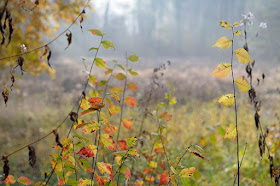▼
October 10, 2017
Field Elm
Autumn leaves begin to fall, and the Field Elm (Ulmus minor) is not late.
Its leaves are toothed and lopsided at their base, but this feature is not visible in the picture above.
For that matter, Field Elm is a tree (or bush) full of symmetry and evenness. The leaves are spaced at equal distances on branches...
... and, then, the little branches are also spaced at equal distances on bigger branches.
On those young trees in winter attire the branches look thick. No, it is not a disease of the bark, it is suberisation. This phenomenen can be found also on other tree species, as the Field Maple (Acer campestre). Crests of cork or thickened bark develop along the boughs. Why? We don't know exactly, may be it as a protection against cold or damage by predators. It seems the tree does not suffer from it.
Anyhow, it is not a symptom of Dutch elm disease, a fungal infection transmitted by a bark beetle, that has led to the dead of many Elm trees all over Europe. Dutch elm disease gives also bark symptoms, but you recognize it mainly because big branches begin to shed leaves and die.
Sometimes you hear saying that Field Elms went practically extinct because of this disease. In fact, this is not true, you still can find many trees, and especially bushes. Mainly isolated trees have survived. Also the diseasy attacks only bigger branches and trunks, new growths are not affected. Also the number of Scolytus beetles (the vector) seems to have gone down in the last years.
In Perigord Field Elm is very common in hedgerows and wood edges, it is also one of the first ligneous plants that appears in abandoned formerly cultivated fields.
Flowering season is early, light green oval fruits appear in March-April, at the same time as new leaves.





